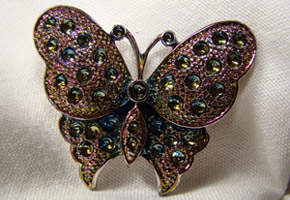Brazilian company develops colored gold jewelry
A goldsmithing technique developed by a company funded through PIPE-FAPESP makes it possible for gold jewelry to be made in any color.
Brazilian company develops colored gold jewelry
A goldsmithing technique developed by a company funded through PIPE-FAPESP makes it possible for gold jewelry to be made in any color.

A goldsmithing technique developed by a company funded through PIPE-FAPESP makes it possible for gold jewelry to be made in any color
By Elton Alisson
Agência FAPESP – The Brazilian gold jewelry market, along with those of China and Russia, has presented the highest growth rates worldwide in recent years, according to the Brazilian Institute of Gemstones and Precious Metals (IBMG).
As a means of distancing themselves from the competition and broadening participation in this market segment – which turned over R$ 5.5 billion in Brazil in 2010 and grew 30% over 2009 – the more than 900 gold jewelry producers in the country are highlighting their design by producing lighter pieces and utilizing gemstones and alternative materials.
A technology developed by the Brazilian company Chancelier, with the support of the FAPESP’s Innovative Research in Small Companies (PIPE), has added another exciting characteristic to gold jewelry design.
The company developed a technique that allows producers to make 18-karat gold jewelry in any color. The pieces also have a high luster, and the color tone changes based on the angle of the light.
“Our idea was to introduce color as one of the elements of gold jewelry design and make a type of patina over conventional gold,” noted Edval Gonçalves de Araújo, a metallurgical engineer and partner in Chancelier, in an interview with Agência FAPESP.
Through a technique called sputtering, a colored gold alloy target is placed in a vacuum chamber where it is bombarded with argon and oxygen.
Because of the high difference in tension, the gases remove the gold, iron, chrome and cobalt atoms from the target, which are deposited on the surface of the piece. Using this process, a layer covers the gold jewelry, and by controlling the depth of the film, it is possible to add the desired color to the piece.
“This process is much more practical than what we have used to date. Now we can cover any piece with colored gold,” commented Araújo.
According to the researcher, the technology began to be developed in 2003 by a group at the Institute of Nuclear Energy Research (Ipen), which included Araújo. The researchers found an alloy comprising 75% gold and 25% iron, chromium, cobalt and other metals, instead of the 25% silver and copper that form the alloy traditionally used in 18-karat gold.
With this technology, however, it was possible to make only one-tone colored jewels using folded or cut sheets covering the entire piece. These sheets, when heated in a furnace below the melting point – in a step known as sintering – acquire white, gold, purple, blue, gray and black colors owing to the oxidation of the mixture of iron, chrome and cobalt.
In 2005, with the
support of PIPE, Araújo began to research new alloys and techniques for obtaining colored gold in a compound with conventional gold.
The research resulted in the development of sputtering, which allows producers to cover any gold piece in its final format with different tones, which are applied to selected areas of the jewelry.
“Through this technique, we can make, for example, a gold earring or ring in the shape of a butterfly with the colors of the rainbow,” explained Araújo.
Colored gold rings
To introduce the technology onto the market, the company developed a collection comprising earrings, pendants, necklaces and rings and commissioned a market potential study. The study was conducted by the Getúlio Vargas Foundation (FGV), on a group representing 92,000 women in Greater São Paulo – a region that accounts for half of the jewelry consumption in the country.
The study participants affirmed that they would buy colored gold jewelry and would pay an average of 50% more for the pieces than for conventional gold jewelry, which would create a new niche market with an estimated R$ 66 million turnover.
Based on these findings, the company has begun large-scale manufacturing of these pieces, also under the
auspices of PIPE. It will launch a line of wedding rings, which, together with rings, account for approximately 50% of jewelry sold in Brazil. Currently, wedding ring sales account for 4.6 tons of gold in Brazil, with a turn over of R$ 700 million annually.
“We intend to introduce technology in a new market niche and gradually conquer other consolidated segments. The idea is to broaden wedding ring options, creating details and introducing color as a component of the design, which can be accented with diamonds, color or even gemstones,” explains Araújo.
According to Araújo, the colored gold rings will not be more expensive to make than conventional rings because the sputtering process is not expensive and makes it possible for thousands of pieces to be colored at once.
The pieces will initially be sold in São Paulo and later in other states, including Santa Catarina, Paraná and Rio Grande do Sul, where the company has representatives.
In addition to ready-made pieces, the company will offer gold coloring services to jewelers and jewelry designers. “We have a factory assembled, and we have made an agreement with a company that manufactures sputtering equipment to apply this type of treatment to gold jewelry,” said Araújo.
The manufacturing technology for colored gold alloys has been patented, with
funding through FAPESP’s Intellectual Property Support Program (PAPI), and the sputtering technique is in the process of being patented.








